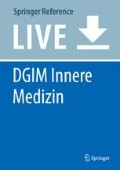Zusammenfassung
Der arterielle Blutdruck ist ein Produkt aus kardialer Auswurfleistung und systemischem Gefäßwiderstand. Ein optimaler Blutdruck entspricht dem Druck, der eine adäquate systemische Perfusion gewährleistet, ohne unnötige kardiale Arbeit oder Gefäßschäden in den Endorganen (z. B. Herz, Niere, Gehirn) zu verursachen. Eine arterielle Hypertonie entspricht demnach einem inadäquat hohen systemischen Blutdruck, der zu Endorganschäden führt.
Literatur
Agarwal F (2010) Regulation of Circadian Blood Pressure – From Mice to Astronauts. Curr Opin Nephrol Hypertens 19(1):51–58
Brantsma AH, Bakker SJ, de Zeeuw D, de Jong PE, Gansevoort RT (2008) PREVEND Study Group Extended prognostic value of urinary albumin excretion for cardiovascular events. J Am Soc Nephrol 19:1785–1791
Calhoun D, Jones D, Textor S et al (2008) Resistant hypertension: diagnosis, evaluation, and treatment: a scientific statement from the American Heart Association Professional Education Committee of the council for high blood pressure research. Circulation 117:510–526
Deutsche Hochdruckliga e.V. (DHL) (2014) ESC Pocket Guidelines. Leitlinien für das Management der arteriellen Hypertonie. www.hochdruckliga.de. Zugegriffen am 20.10.2014
Mancia G, Fagard R, Narkiewicz K et al (2013) ESH/ESC Guidelines for the Management of Arterial Hypertension: the Task Force for the Management of Arterial Hypertension of the European Society of Hypertension (ESH) and of the European Society of Cardiology (ESC). Eur Heart J 34(28):2159–2219
Schlaich M, Straznicky N, Lambert E, Lambert G (2014) Metabolic syndrome: a sympathetic disease? Lancet Diabetes Endocrinol pii:S2213-8587(14)70033-6
Sharma AM, Wittchen H-U, Kirch W, Pittrow D, Ritz E, Göke B, Lehnert H, Tschöpe D, Krause P, Höfler M, Pfister H, Bramlage P, Unger T (2004) High prevalence and poor control of hypertension in primary care: cross-sectional study (HYDRA-study). J Hypertens 22:479–486
Wolf-Maier K, Cooper RS, Banegas JR et al (2003) Hypertension prevalence and blood pressure levels in 6 European countries, Canada, and the United States. JAMA 289:2363–2369
Author information
Authors and Affiliations
Corresponding author
Editor information
Editors and Affiliations
Rights and permissions
Copyright information
© 2014 Springer-Verlag Berlin Heidelberg
About this entry
Cite this entry
Sayk, F. (2014). Arterielle Hypertonie - Diagnostik und Risikostratifizierung. In: Lehnert, H. (eds) SpringerReference Innere Medizin. SpringerReference Medizin. Springer, Berlin, Heidelberg. https://doi.org/10.1007/978-3-642-54676-1_280-1
Download citation
DOI: https://doi.org/10.1007/978-3-642-54676-1_280-1
Received:
Accepted:
Published:
Publisher Name: Springer, Berlin, Heidelberg
Online ISBN: 978-3-642-54676-1
eBook Packages: Springer Referenz Medizin

